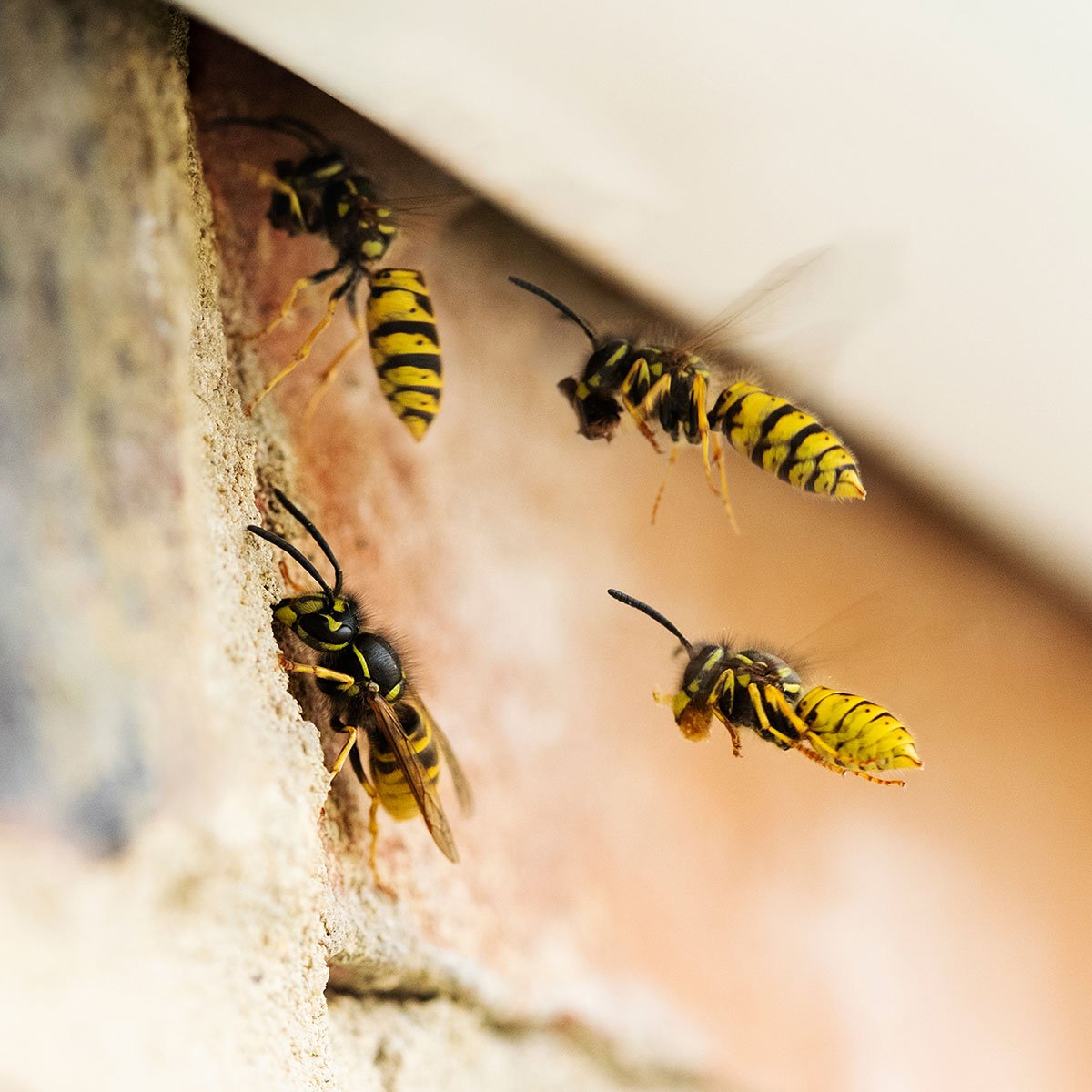
A close relation of the bee, the wasp species includes common wasps, hornets and tree wasps. The nests of social wasps may contain up to 5,000 insects, but most have only one fertile female called the queen, who lives with female workers and males (who hatch only in the breeding season). Common wasps are 10-15mm long, with the queens slightly larger at 20mm. Hornets are among the largest wasps and grow up to 25mm long. Many types of wasp can be identified by their striped bodies, which warn other animals of their painful sting.
Queen wasps make a new nest in the spring in which to lay eggs and feed the grubs until they grow into female worker wasps. This takes three to four weeks, and up to 30,000 wasps can be found in a single nest. The workers then seek sweet food such as fruit, plant sap and flower nectar, but this can create a nuisance and the wasps will sting if threatened.
Wasp nests are often found in walls, roofs, eaves, sheds and the ground. Apart from being unpleasant, a wasp sting can cause a severe reaction known as anaphylactic shock in some people, so it’s important not to threaten or disturb a wasp nest but instead to call in professional help.
For help with wasps, please get in touch.
Have you found a wasps nest?
Fleas are tiny, wingless parasites measuring approximately 2mm and with a lifecycle of approximately four weeks. Flea larvae feast on feathers, fur and organic matter. Adult fleas are amazing leapers and exist exclusively on the blood of mammals and birds, potentially passing on diseases from one host to another.
Household pets such as cats and dogs are regular breeding grounds for fleas, and infestations are also commonly found in homes previously occupied by domestic animals. The larvae wrap themselves in silk cocoons and having reached maturity, the adult fleas can remain dormant for over two years and will only emerge when they sense the vibrations of a nearby host.
People react differently to flea bites, ranging from small red marks to more extensive rashes and itching.
Cat fleas are usually responsible for flea bites in humans, although bird fleas and dog fleas are also key culprits. They do not live on human skin, instead taking the opportunity to bite when you’re near the carpet, pet bedding or furnishings they’re inhabiting.
Infested pets should be treated, and all carpets, furnishings and bedding vacuumed and washed thoroughly. Old bird nests should be removed.
We recommend professional control using specific insecticide for quick clearance of large areas and/or persistent infestation. Please get in touch for details.
Fleas making you itch?
Bed bugs are parasites that live and feed on warm-blooded animals, including humans, causing skin rashes and bites. They can crawl up vertical surfaces such as furniture legs, and like to lay their eggs in cracks or crevices located near to the host. The young (nymph) bugs are small and hard to see with the naked eye; adult bugs are brown and disc-shaped, and typically about 3mm in size.
Bed bugs are particularly prevalent in high-occupancy dwellings such as hostels, hotels and blocks of flats. Many infestations have been caused by residents inadvertently bringing back bed bugs from their travels. They can survive in starvation for up to a year, so professional assessment and treatment of a bed bug infestation is essential to ensure that these tenacious creatures have been totally eradicated.
For help getting rid of bed bugs, please contact us.
Help with bed bugs
Silverfish are small, wingless insects that are found in many homes. They are grey or silver in colour and can range in size from 0.5 - 1 inch long. They are most active at night, and they feed on starchy materials such as paper, fabrics, and glue. Silverfish can cause damage to books and clothing. They are common in damp, humid, dark areas such as basements, bathrooms and kitchens.
Contact us about how to get rid of silverfish.
Silverfish
More than 9000 different types of ant are found worldwide and range in size from 1mm to 1cm long. Ants are social insects, and their colonies can be very large, containing many thousands of individuals of different castes. These include flying queen ants and fertile males, who mate in the air during a very short breeding season of a few days in July or August. The queen returns to the ground and removes her wings, rejoining her old nest or starting a new colony.
Worker ants tend the larvae and pupae until they emerge as adult ants. They seek out sweet foods for the queen and larvae, and in doing so often infest properties. Garden Ants are the most common type to cause a problem, and occasionally the smaller Ghost Ants which are attracted to heated buildings. Infestations of Pharoah’s Ants (smaller than garden ants and red/light brown in colour) are being increasingly seen in blocks of flats. They love the communal central heating system, plentiful water supply and availability of food, but can pose a risk to health by transmitting the germs that cause food poisoning. Good hygiene is essential and professional pest control must be brought into eradicate the colonies.
If you’ve got an ant problem, please contact Wessex Pest Control.
Ant infestation?
The larvae of the carpet beetle are renowned for causing damage to carpets, furniture and clothing. Carpet beetle larvae are brown and 4-5mm in length, with protective spines on their bodies which give a hairy appearance and the nickname ‘woolly bears’.
Depending on its supply of food, it can take anything from a few months to a couple of years to go from egg to adult beetle, and the grubs can survive several months of starvation. The larvae spend up to a year of adolescence voraciously eating any textiles, feathers, fur and fluff they come into contact with, hence their reputation as the top fabric pest in UK homes.
Often entering a home via bird nests in the eaves, these creatures like warm environments such as loft spaces, wardrobes and airing cupboards and can be highly resistant to insecticides.
We can help with carpet beetles, please get in touch.
Pest control for carpet beetles
Cluster flies are dark grey with overlapping wings, and they measure approximately 8mm long. Their bodies have a mottled appearance with short golden hairs on the thorax. Cluster flies don’t lay eggs on human food but instead use earthworm burrows, where the larvae then infest the worms.
They are renowned for hibernating in large numbers during the autumn months, entering buildings through small holes in the walls and preferring cavities, roof spaces, attics and dormant rooms in which to overwinter. They appear again in the spring, often congregating at windows and flying slowly around the home.
Cluster flies are important to eradicate because they will return in large numbers year after year if not properly removed.
As well as offering a pest control service for dealing with flies, we also sell electric fly killer machines, uv lamps, glueboards and flyscreens. Please contact us for further details.
Help removing cluster flies
Cockroaches range from 10mm to 25mm long, depending on the type, and look like rather beetles but with long antennae. One egg capsule can contain up to 30 nymph insects, which can reach maturity in just a matter of weeks. They love warm and humid conditions, especially kitchens, laundries and boiler rooms. Cockroaches hide by day and come out at night to forage for any foodstuffs they can find.
A cockroach infestation poses a significant risk to health, contaminating utensils, work surfaces and food with an easily identifiable smell and a high chance of illness from the various diseases they carry. As they tend to seek inaccessible crevices in which to hide, cockroaches have a reputation for being notoriously difficult to get rid of.
If you have cockroach issues, contact us for help.
Cockroaches a problem?
Flies are one of the largest insect orders after beetles, and their transmission of diseases that can infect our food makes them unpopular. It has a four-stage life cycle, from eggs to maggots, and pupae to adult flies. Taste sensors on the feet of house flies help it to detect its food, which it eats by vomiting saliva onto the surface and then sucking up using its sponge-like mouth. This contaminates the food with bacteria; flies can transmit food poisoning and other diseases such as cholera and typhoid.
House flies and bluebottles are most commonly found in the UK. House fly larvae are white, tapered and up to 12mm in length when mature, with the adult flies measuring 5-8mm. They lay their eggs in batches of 120-150, which can hatch into larvae in hours, and are particularly fond of decaying vegetable matter. Bluebottles have larger larvae and adult flies which measure up to 18mm, and can be identified by their metallic blue bodies. They can lay up to 600 eggs, which will become fully developed maggots within a week. The maggots feed on meat, especially dead rodents or birds, before emerging as adult flies.
As well as offering a pest control service for dealing with flies, we also sell electric fly killer machines, uv lamps, glueboards and flyscreens. Please contact us for further details.
How to get rid of flies
Read our reviews…









